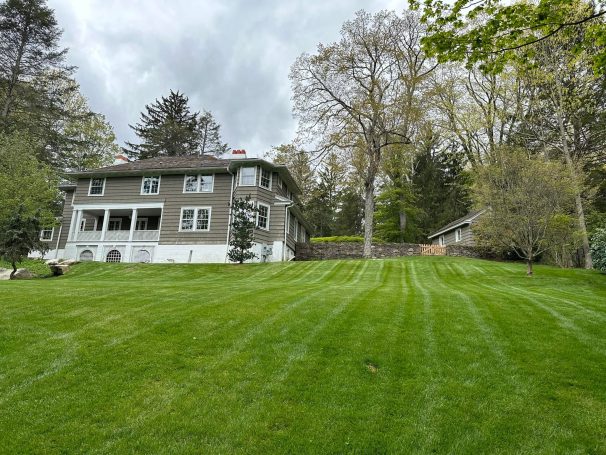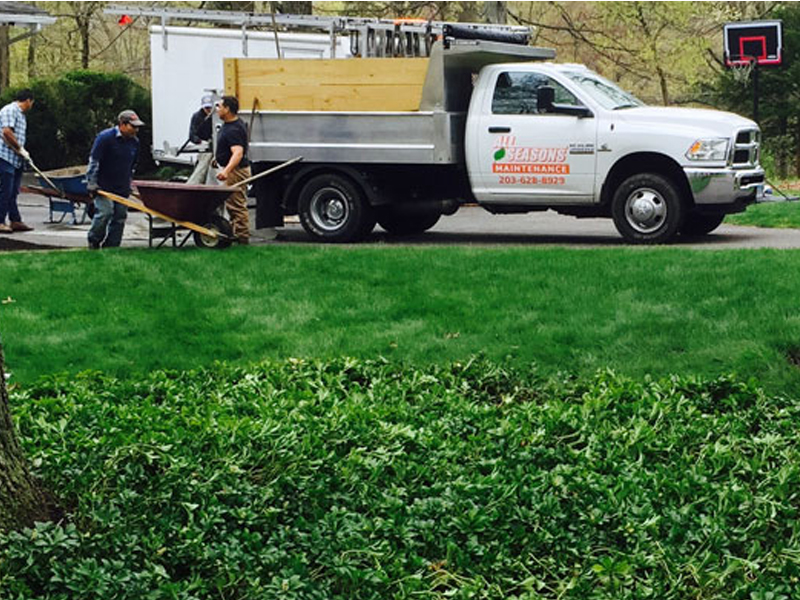Why Fall Aeration and Overseeding Transforms Your Lawn
Want to know the secret to a lawn that makes your neighbors jealous? It’s not what you do in spring – it’s what you do in fall. While most homeowners pack away their lawn care tools after summer, the smartest ones are just getting started on the most important lawn care tasks of the year: aeration and overseeding.
Think of aeration and overseeding as the dynamic duo of lawn care. Aeration opens up your soil so grass roots can breathe and absorb nutrients, while overseeding fills in bare spots and thin areas with fresh, healthy grass. If you’ve been battling a lawn that never quite lives up to your expectations, this fall is your opportunity to turn things around.

Common Lawn Problems That Aeration and Overseeding Fix
Soil compaction is one of the biggest problems facing Connecticut lawns. Between our clay-heavy soils, years of foot traffic and natural settling over time, your lawn’s soil gets packed down tight. When soil is compacted, it prevents water, air and nutrients from reaching grass roots. You’ll notice water pooling after rain, rock-hard soil and weak grass growth.
Grass naturally thins over time as individual plants age and die off. Bare patches and worn areas create opportunities for weeds to move in. Combined with thatch buildup and poor drainage, you end up in a frustrating cycle where compacted soil leads to thin grass, thin grass allows more weeds and more foot traffic causes more compaction.
The good news? Aeration and overseeding address all of these issues simultaneously, breaking the cycle and giving your lawn a fresh start.
What Is Lawn Aeration and Why Does It Matter?
Aeration is the process of removing small plugs of soil from your lawn, creating thousands of holes that allow oxygen, water and nutrients to reach your grass roots. Core aeration physically removes soil plugs rather than just poking holes, which prevents making compaction worse.
Those holes create channels deep into your soil where grass roots can expand and grow stronger. For Connecticut lawns with clay-heavy soils, aeration is essential for breaking up compaction and improving drainage during our wet fall and spring seasons. The soil plugs left on your lawn’s surface break down naturally over a few weeks, returning valuable nutrients back to your soil.
For detailed information on soil management in Connecticut, the UConn Home & Garden Education Center offers excellent resources. When you’re ready to address your lawn’s compaction issues, our Westbrook lawn care services provide the comprehensive approach your yard needs.
Understanding Overseeding and Why It Pairs With Aeration
Overseeding spreads grass seed over your existing lawn to fill in thin areas and increase overall density. This strategic approach combats natural thinning by constantly introducing fresh, vigorous grass plants.
Here’s where the magic happens: those thousands of aeration holes become perfect seed beds. When grass seed falls into these holes, it makes direct contact with soil – critical for good germination. Seeds nestled in aeration holes are protected and have access to everything they need to sprout and grow.
Overseeding delivers multiple benefits beyond filling bare patches. It introduces newer, disease-resistant grass varieties and creates a thick lawn that naturally crowds out weeds. A dense, healthy lawn means less time and money spent on weed control. Proper nutrition helps new grass establish, which is where professional fertilization services provide the right nutrients at the right time.
Fall is the perfect time in Connecticut because soil is still warm from summer while air temperatures have cooled to the ideal 60-75°F range. Fall brings consistent rainfall and dramatically reduced weed competition. Your new grass has several weeks to establish strong roots before winter, giving you a thick lawn ready to thrive in spring. For guidance on grass varieties for Connecticut, check out this UConn lawn renovation guide.
When to Aerate and Overseed Your Connecticut Lawn
For Connecticut homeowners, the ideal window runs from early to mid-September through early October. This timing gives you warm soil (above 50°F) for germination combined with cool air that grass loves. Your new grass needs 4 to 6 weeks of growing time before the first hard frost in late October or early November.
Spring doesn’t work because you’re fighting aggressive weed growth and unpredictable weather. Summer heat and drought stress make establishment nearly impossible. Fall is when cool-season grasses are genetically programmed to thrive.
Wait until daytime temperatures are consistently in the 60s and 70s and watch for your lawn to naturally green up from summer dormancy. Plan your work when rain is forecasted to help new seed establish.
How Professional Aeration and Overseeding Work
Professional core aeration uses commercial-grade machines that penetrate 2 to 3 inches deep, pulling out soil plugs. These machines make multiple passes for thorough coverage throughout your entire yard. The soil plugs left on the surface break down over the next week or two, returning organic matter to your lawn.
Prepare your lawn by mowing to normal height and marking any irrigation heads or obstacles. If soil is very dry, water the day before – moist soil allows deeper core extraction.
Rental aerators are available, but they’re heavy (150+ pounds), physically demanding and less powerful than commercial equipment. Rental machines often don’t penetrate as deeply, especially in heavily compacted soil. Professional experience ensures proper coverage and technique. Our lawn care services include commercial-grade equipment and experienced operators for thorough results.
Overseeding happens immediately after aeration – ideally the same day. For Connecticut lawns, the best choices are Kentucky bluegrass, perennial ryegrass and fine fescues. Consider your conditions: fine fescues for shade, perennial ryegrass for traffic areas and Kentucky bluegrass for full sun. Quality seed matters – it germinates better and produces more disease-resistant grass.
After seeding, keep areas consistently moist (not soaked) for 2 to 3 weeks through light, frequent watering. Avoid heavy foot traffic until grass establishes. Wait until new grass reaches 3 to 4 inches before the first mowing. Expect germination in 7 to 14 days depending on grass variety and conditions. Our property maintenance services provide consistent care through establishment and beyond.
What to Expect After Treatment
Your lawn will look rough for the first few days with soil plugs visible. Around day 7 to 14, you’ll see first signs of germination. By weeks 2 to 4, new grass actively fills in thin areas as soil cores disappear. Around week 6, you’ll notice significant improvement in thickness and appearance.
The real payoff shows next spring when you have a thick, healthy lawn ready to take off. You’ll see better drought tolerance, fewer bare spots, improved color and greater resilience to stress. Continue normal maintenance once grass is established, including mowing, watering if fall is dry and keeping up with leaf removal.
Professional Service vs. DIY
Professional aerators pull deeper cores and handle compacted soil better than rental equipment. Experience in technique, seed selection and problem identification makes a significant difference. The physical demands of operating heavy rental equipment exhaust most homeowners and the time investment is substantial – professionals complete both tasks in 1 to 2 hours versus a full DIY day.
Professional service provides commercial-grade equipment, proper seed application, knowledge of local conditions and coordination of both treatments on the same day. Think long-term: a healthier lawn means fewer problems, less weed control and less maintenance over time. For most homeowners, professional service delivers superior results with far less hassle.
Transform Your Lawn This Fall
Fall aeration and overseeding is the foundation for creating the thick, healthy lawn you’ve always wanted. These treatments solve compacted soil, thin grass, bare patches and weak root systems. The combination of warm soil, cool air and lower weed pressure creates ideal establishment conditions. By next spring, you’ll see a noticeably thicker lawn with better color, drought tolerance and fewer bare spots.
Don’t let another year go by. Fall’s optimal window closes as we move into late October.
All Seasons Maintenance specializes in professional aeration and overseeding for Connecticut homeowners. Our commercial-grade equipment ensures thorough results, we select the right seed varieties for your conditions and our experienced team handles everything from preparation to post-treatment guidance. We understand Connecticut lawns, soil conditions and the timing that produces the best results.
Ready to give your lawn the fall transformation it deserves?
Call us today at (203) 885-0001 or request a free quote. Let’s work together to create the lush, green lawn that makes your home stand out.

